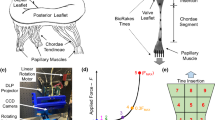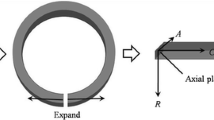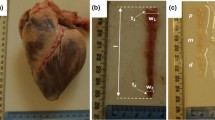Abstract
In uniaxial tensile testing, load preconditioning is used to generate repeatable load/elongation curves and set a “reference state” for subsequent tensile tests. We have observed however, that for porcine aortic valve (PAV) tissues, preconditioning does not lead to repeatable stress relaxation curves. We thus investigated possible experimental protocols that could be used to generate repeatable load/elongation and stress relaxation curves. To quantify repeatability of stress relaxation, we compared normalized loads at the same time points from repeated stress relaxation curves and computed a repeatability ratio. We found that PAV specimens can generate repeatable stress relaxation curves (repeatability ratio >0.95) if they are subjected to at least five cycles of repeated load preconditioning and stress relaxation. We also found that a single cycle of loading/unloading prior to each stress relaxation phase is sufficient to generate repeatable stress relaxation curves. Stress relaxation preconditioning is therefore required to generate repeatable load/elongation and stress relaxation curves. It is expected that such curves will generate more accurate material constants for the characterization and modeling of PAV mechanics.
Similar content being viewed by others
REFERENCES
Anderson, E. R., J. E. Barber, and I. Vesely. Preconditioning characteristics of porcine aortic valve tissue. Abstract Book of the First Joint Meeting of BMES and EMBS, Atlanta, 1999, 131pp.
Bashey, R. I., T. Shinichiro, and A. Angrist. Age-related collagen and elastin content of human heart valves. J. Gerontol. 22:203–208, 1967.
Baxter, B. T., G. S. McGee, V. P. Shively, I. A. S. Drummond, S. N. Dixit, M. Yamauchi, and W. H. Pearce. Elastin content, cross-links, and mRNA in normal and aneurysmal human aorta. J. Vasc. Surg. 16:192–200, 1992.
Carew, E. O., J. E. Barber, and I. Vesely. Role of preconditioning and recovery time in repeated testing of aortic valve tissues: Validation through quasi-linear viscoelastic theory. Ann. Biomed. Eng. 28:1093–1100, 2000.
Carew, E. O., E. A. Talman, D. R. Boughner, and I. Vesely. Quasi-linear viscoelastic theory applied to internal shearing of porcine aortic valve leaflets. J. Biomech. Eng. 121:386–392, 1999.
Duncan, A. C., D. Boughner, and I. Vesely. Viscoelasticity of dynamically fixed bioprosthetic valves. II. Effect of glutaraldehyde concentration. J. Thorac. Cardiovasc. Surg. 113:302–310, 1997.
Fung, Y. C. Biomechanics: Mechanical Properties of Living Tissues, 2nd ed. New York: Springer-Verlag, 1993, pp. 260–262.
Fung, Y. C., and S. S. Sobin. The retained elasticity of elastin under fixation agents. J. Biomech. Eng. 103:121–122, 1981.
Hart, M. L., S. A. Beydler, and W. H. Carnes. The fibrillar structure of aortic elastin. Scan. Electron Microsc. 11:21–28, 1978.
Haut, R. C., and R. W. Little. A constitutive equation for collagen fibers. J. Biomech. 5:423–430, 1972.
Kwan, M. K., T. H.-C. Lin, and S. L.-Y. Woo. On the viscoelastic properties of the anteromedial bundle of the anterior cruciate ligament. J. Biomech. 26:447–452, 1993.
Lee, J. M., D. W. Courtman, and D. R. Boughner. The glutaraldehyde-stabilized porcine aortic valve xenograft. I. Tensile viscoelastic properties of the fresh leaflet material. J. Biomed. Mater. Res. 18:61–77, 1984.
Lee, J. M., S. A. Haberer, C. A. Pereira, W. A. Naimark, D. W. Courtman, and G. J. Wilson. High strain rate testing and structural analysis of pericardial bioprosthetic materials. In: Biomaterials' Mechanical Properties ASTM STP 1173, edited by H. E. Kambic, and A. T. Yakabori. Philadelphia: ASTM, 1994, pp. 19–42.
Leeson-Dietrich, J., D. R. Boughner, and I. Vesely. Porcine pulmonary and aortic valves: A comparison of their tensile viscoeleastic properties at physiological strain rates. J. Heart Valve Dis. 4:88–94, 1995.
Myers, B. S., J. H. McElhaney, and B. J. Doherty. The viscoelastic responses of the human cervical spine in torsion: experimental limitations of quasi-linear theory, and a method for reducing these effects. J. Biomech. 24:811–817, 1991.
Pinto, J. G., and P. J. Patitucci. Visco-elasticity of passive cardiac muscle. J. Biomech. Eng. 102:57–61, 1980.
Provenzano, P., R. Lakes, T. Keenan, and R. Vanderby Jr. Nonlinear ligament viscoelasicity. Ann. Biomed. Eng. 29:908–914, 2001.
Sacks, M. S. Biaxial mechanical evaluation of planar biological materials. J. Elasticity 61: 199–246, 2000.
Sauren, A. A. H. J., M. C. van Hout, A. A. van Steenhoven, F. E. Veldpaus, and J. D. Janssen. The mechanical properties of porcine aortic valve tissues. J. Biomech. 16:327–337, 1983.
Scott, M., and I. Vesely. Aortic valve cusp microstructure: The role of elastin. Ann. Thorac. Surg. 60:S391–S394, 1995.
Vesely, I., and J. E. Barber. The role of tissue preconditioning in measuring stress relaxation behavior of heart valve tissues. Proceedings of the third World Congress of Biomechanics, Sapporo, Japan, 1998, 193pp.
Vesely, I., and A. R. Brewer. Preconditioning does not reset the strain history of uniaxially tested, porcine aortic valve tissues. ASME Bioeng. Div. Publ. BED 17:57–58, 1997.
Woo, S. L.-Y., M. A. Gomez, and W. H. Akeson. The time and history-dependent viscoelastic properties of the canine medial collateral ligament. J. Biomech. Eng. 103:293–298, 198.
Author information
Authors and Affiliations
Rights and permissions
About this article
Cite this article
Carew, E.O., Garg, A., Barber, J.E. et al. Stress Relaxation Preconditioning of Porcine Aortic Valves. Annals of Biomedical Engineering 32, 563–572 (2004). https://doi.org/10.1023/B:ABME.0000019176.49650.19
Issue Date:
DOI: https://doi.org/10.1023/B:ABME.0000019176.49650.19




